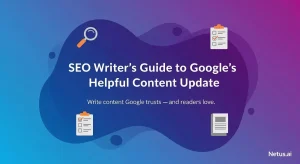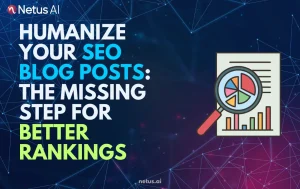
Google’s Helpful Content Update: An SEO Writer’s Guide | NetusAI
SEO Writer’s Guide to Google’s Helpful Content Update Keeping up with Google’s algorithm changes can feel like a relentless game of whack-a-mole. Just when you
How to Deal with Duplicate Content Penalties: Expert Solutions

Content writer and editor for Netus.AI
How to Deal with Duplicate Content Penalties. Understanding the concept of a duplicate content penalty is essential to safeguard the efforts of content creators like manufacturers and to maintain the integrity of online information. By implementing strict measures against plagiarism, the interests of content creators are protected. Knowledge of these penalties also assists searchers in ensuring that the information they find is original and reliable. Combating plagiarism across various sectors, including academics, contributes to a more authentic and valuable internet experience.
Plagiarism involves producing duplicate content by using someone else’s work without proper attribution. This can include copying text, ideas, images, or any other form of content without recognizing the original creator. This action is considered a copyright violation, and can lead to penalties for both content scrapers and those who unknowingly share copied content.
To avoid plagiarism, it is essential to rewrite the borrowed material and provide appropriate credit to the source, respecting the author’s rights and maintaining the integrity of your own work.
Plagiarism has become a widespread issue, encompassing not only written words but also images, music, ideas, and various performing arts. It is particularly prominent in academia, where students, teachers, and researchers are involved in numerous written tasks, such as research papers that necessitate originality and creativity. Scraped content is an example of how plagiarism can occur on the internet, further emphasizing the urgency of addressing this growing concern.
Thanks to modern technology and software, detecting plagiarism has become more accessible and efficient. Proofreading manually is no longer necessary, as numerous online tools are available for free and detect copied content within minutes by comparing documents.
Additionally, institutions control plagiarism by implementing copyright laws on digital and printed content, which prohibit unauthorized access to data and protect creators’ rights.
Copyright protection serves to prevent unauthorized use of original content created by an organization and provides legal backing. Infringing on copyright can result in both monetary losses and reputational damage for the offender.
When online content is found to be duplicate and does not pass plagiarism checks, penalties may be imposed on the content creator. In some cases, the infringing content may even be removed from websites due to copyright violations.
Duplicate content can negatively impact a website’s reputation and search engine rankings. While Google and other search engines may not delete or impose legal charges for duplicate content, it is essential to handle duplicate content penalties effectively.
Such penalties arise when content is found to be strikingly similar or partially mirroring other content available in search engines. Each search engine handles duplicate content in different ways, leading to ambiguities regarding consequences for plagiarism.
Identifying the original source of content becomes the primary focus of search engines instead of directly penalizing websites for posting duplicate content. They strive to showcase the original article, blog, or content over the copied versions when multiple duplicates are available.
Handling SEO issues stemming from duplicate content penalties necessitates taking several steps:
Despite Google and other search engines not actively penalizing websites for duplicate content, it is essential to handle such issues responsibly. Website owners must prioritize original content to maintain their rankings and ensure a positive user experience. Professionalism and ethical behavior are crucial for lasting success in the competitive world of SEO and digital marketing.
Make efforts to be original by conducting research, reading, and creating multiple drafts. Develop creative ideas rather than relying on other people’s work.
One effective approach to avoid plagiarism is to utilize online plagiarism checker tools. Check for plagiarism before publishing to ensure content is unique.
If you choose to use someone else’s work, follow appropriate citation guidelines. Properly credit original content creators when summarizing, paraphrasing, or borrowing ideas.
Implement 301 redirects to guide search engines and users towards the original content source. Redirects help prevent the display of duplicate content on search results.
The canonical tag enables search engines to recognize the original source page of copied content, particularly when multiple similar versions exist. Place the canonical tag in the HTML head of the preferred domain.
Control search results by adjusting URL parameters and removing duplicate content from websites. Set passive parameters to prevent duplicate content issues and maintain a positive user experience.
Incorporating these best practices can help reduce plagiarism risks, avoid duplicate content penalties, and maintain a website’s credibility in the eyes of users and search engines.
As plagiarism and duplicate content continue to rise, utilizing a reliable duplicate content checker has become essential. Copyleaks is a powerful tool that employs AI and machine learning technologies to accurately detect plagiarism and ensure originality. This helps users avoid duplicate content penalties with confidence.
To further enhance your website’s quality and maintain original content, consider using other tools alongside Copyleaks, such as:
Using these tools together can ensure genuine and quality content, resulting in better online performance.
There is no specific threshold for acceptable duplicate content. However, consistently providing unique and valuable content is recommended to avoid potential penalties. Google focuses on ranking original content and does not penalize websites for occasional duplicate content.
To avoid penalties, use canonical tags or cross-domain rel=”canonical” tags. This informs search engines that a specific URL is the original version of the content on the multiple domains.
Some recommended tools for identifying duplicate content include:
Google identifies and consolidates duplicate content, prioritizing the original or most relevant page for search rankings. However, penalties are not typically applied if the duplicate content is not malicious.
Efficient ways to resolve duplicate content problems include:

SEO Writer’s Guide to Google’s Helpful Content Update Keeping up with Google’s algorithm changes can feel like a relentless game of whack-a-mole. Just when you

Can AI Content Be Safe for SEO in 2025? Let’s start with the question of keeping every content strategist, SEO pro and blogger awake at

Humanize Your SEO Blog Posts: The Missing Step for Better Rankings You’ve done everything by the book. Your keyword research is impeccable. Your meta descriptions

How to Pass AI Detection Tests as an SEO Writer Let’s paint a familiar picture. You’ve just finished a blog post. The headline is sharp,

Why Your AI SEO Blog Isn’t Ranking (And How to Fix It) You embraced AI for your blog. The promise was intoxicating: high-quality content, published

The Modern SEO Writer’s Stack: Tools to Stay Ahead in AI-Powered Search Remember the days when “SEO writing” conjured images of frantic keyword stuffing, awkward
@ 2024 Netus AI.